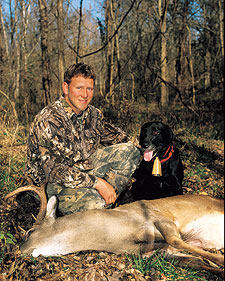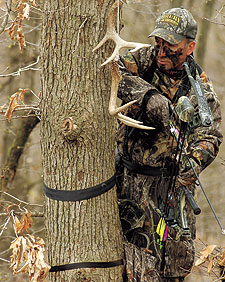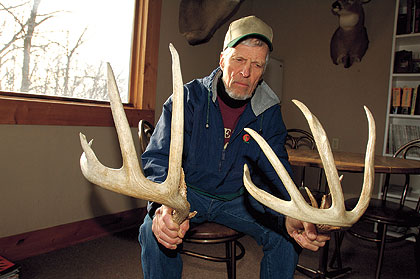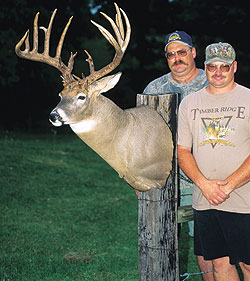March 21, 2011
By Bill Winke
Bill Winke looks for answers about a deer's sixth sense, scrapes, nocturnal bucks, cloning, and is a single-lung shot enough to kill a deer.
Advertisement

Advertisement
Most single-lung hits on deer are fatal, but they can make recovery a challenge. |
For all we've learned about whitetails over the past couple decades, there's a heck of a lot we still don't know. After sitting down and thinking about it for a while, I came up with a list of five of the most significant and puzzling unanswered questions in deer hunting.
Some are serious. Some are simply entertaining. But all are thought provoking. The answer to all of these questions is either "maybe," "usually" or "sometimes." In short, these are the murky gray areas we all encounter when bowhunting.
Do Deer Have A Sixth Sense?
I know a couple prominent hunters who, for a while at least, were lining their hunting caps with aluminum foil to prevent brain waves from escaping. It sounds nutty, and it probably is, but I have a story to offer that may cause you to wonder. And I'll bet you can think of some similar stories of your own.
One sunny October day, I got to my stand early and, rather than climb up, I simply leaned against the base of the tree for a nap. A while later, I awoke and found myself staring straight at a doe about 15 yards away. I doubt she had made enough noise to wake me, so that was interesting in itself. But the best part happened a moment later.
The only things that moved on my whole body were my eyelids — I know that. Yet almost immediately after my eyes popped open, the doe whipped her head around, stared straight at me and bolted as if I'd shocked her with a cattle prod. It was as if she had read some change in the natural order of things. It was definitely weird.

 ADDITIONAL READ: Post-Season Scouting Strategy For Bowhunters
ADDITIONAL READ: Post-Season Scouting Strategy For Bowhunters
OK, my story offers no conclusive evidence that deer can read our intentions from some electromagnetic field we transmit, but I won't say it's impossible. I feel I have experienced a sixth sense at times, so why not deer? Their lives depend on tuning into this phenomenon more than mine. Do deer have a sixth sense? Who knows, but I believe some probably do.
Some deer, such as the doe I mentioned, seem to know when someone is looking at them. It's one reason many experienced hunters never look directly at a deer's head when it's near their stand. Still, I'm not ready to don the foil hat just yet.
What Do Scrapes Really Mean?
Biologists once theorized scrapes served as a place for bucks to meet does. Bucks left their calling cards in the form of urine. An estrus doe stopped by, smelled the urine and, if she liked the condition of the buck that placed it, she urinated also. Then she bedded down nearby to await the buck's return. Ahh, if only it were that easy! Perhaps, in places where you can count the number of deer per square mile on one hand, such a system might be nature's way. But in the places I hunt, bucks totally abandon their scrapes when the rut peaks. And, if this theory is true, why have I never seen a doe actually urinate in a scrape, or even pay them any mind for that matter?
More recently, biologists have adjusted their theory. Now, they think scrapes serve as a rut-priming tool to get the herd on the same page and ready for breeding at the same time. Maybe. But again, that seems a little more organized than what I see in the woods every fall.
 Some veteran bowhunters won't look directly at a deer's face when it is close to the stand because they are afraid the deer will detect their presence through a sixth sense. |
Could it be that scrapes are a way for bucks to keep tabs on other bucks, like a male dog that lifts his leg on the mailbox post at the end of the driveway?
From my own observations, that seems most plausible. It appears scrapes are made by bucks to communicate to other bucks, but no one knows for sure.
When we finally figure out all the information scrapes contain and how deer use that information, we'll be able to figure out when and how to hunt them most effectively. Until then, I suggest keeping things simple. Hunt scrapes soon after they are made, because at these times the scrapes reveal a buck's travel pattern. The buck that made them obviously came through that way and may do so again soon.
Why Are Some Bucks Nocturnal?
Some bucks are nocturnal and others aren't. Why? I hunted one buck that lived near my house for a whole season and never saw him. Yet his shed antler showed up in the same area late that winter.
First off, most mature bucks are naturally nocturnal outside their summer feeding binge. Even during the rut, many big bucks are nearly invisible.

 ADDITIONAL READ: Tips For Spotting Game While Hunting
ADDITIONAL READ: Tips For Spotting Game While Hunting

 Studies by Dr. Grant Woods show that once a buck reaches 4.5 years old, his daylight activity during the rut starts to decline from a peak reached when he was 3.5 years old.
Studies by Dr. Grant Woods show that once a buck reaches 4.5 years old, his daylight activity during the rut starts to decline from a peak reached when he was 3.5 years old.
Second, mature bucks don't breed as many does as a lot of people once thought. Biologist and whitetail nut C.J. Winand told me a study he knew of using DNA samples from deer in a free-ranging herd determined (at least in the herd studied) the dominant buck doesn't do all, or even most, of the breeding. In the study, 1.5-year-old bucks bred roughly one or two does each, 2.5-year-old bucks bred one or two does each, 3.5-year-old bucks bred three does each and 4.5-year-old bucks bred two does each.
Apparently, the rut doesn't drive older bucks to their feet as much as we may have thought or hoped. Deer are like humans in that they have a wide range of personalities that can change throughout their lives. For the most part, young people — and young deer — are less reserved and more active than older folks. You see the youngsters more often, while some older people rarely leave their homes. Bucks are similar. When they reach maturity, some are more outgoing than others. It's a matter of personality, which develops over time.
I asked Woods about the personalities of deer. He assured me the individual personalities of bucks would take precedence over all other factors in determining their daily habits. In other words, there is no such thing as a stereotypical mature buck. They are all different.
You have to get to know each one individually.
Woods elaborated by saying a certain percentage of the bucks that seem to disappear are still around. They may not be smarter, but they do have personalities that produce behavioral patterns that keep them out of harm's way.
Though they don't breed all the does, I believe mature bucks make every effort to breed the first one that comes into estrus in their core area each year. If a nocturnal old buck is going to slip up, that is one of the most likely times. Make it your mission to learn when the first does come into estrus in your area and be out there hunting your best stands when it happens.
 The author saw the buck that dropped the antler pictured in this man's right hand several times during the summer but never saw him during the season though he hunted him regularly. Then the shed antler showed up in the same area that winter. Why are some bucks nocturnal while others aren't? |
Can We Clone A World-Record Deer?
Turning, you see a buck so big he has to rock his rack from side to side just to walk through the willow thicket. The buck looks just like the world-record typical Mel Johnson shot in Illinois more than four decades ago. The buck is following a doe, but another buck is following him. To your utter amazement, this buck looks exactly like the enormous non-typical mutant shot by bowhunter Mike Beatty in Ohio nearly 10 years back. What's going on here?
Is it a dream, or is it truly possible to clone these deer and reproduce their exact antler traits in other bucks? It's an interesting question to ponder.
A needle jabs through the protective layer surrounding an unfertilized egg that a few hours before was harvested from a living ovary. In one deft movement, a researcher sucks out the egg's nucleus. Next, he uses a second needle to inject another whole cell into its place.
With the flip of a switch, a pulse of electricity fuses the transplanted nucleus to the walls of the empty egg. A second electric shock stimulates the cell to split. Within a couple days, the single cell becomes a mass of cells large enough to implant into a surrogate mother. Months later, the clone is born.
 ADDITIONAL READ: Shake Off That Miss -- Restore Your Bowhunting Confidence Now!
ADDITIONAL READ: Shake Off That Miss -- Restore Your Bowhunting Confidence Now!

Of course, there are problems. One test facility I researched went through 692 enucleated cow eggs to produce one viable calf, which died a few months later from infection. Nevertheless, technology is advancing. We can clone whitetail deer just as easily as sheep or cattle.
It might be reasonable to suggest a cloned buck would have the same antler potential as the donor father, but many other factors will play a critical role in determining how big its antlers actually become.
Woods told me growing big deer takes the right environment. He knows a breeder who, using standard breeding practices -- not cloning -- has grown a buck that carried a 200-inch set of antlers at age 2.5! The breeder did it by completely removing every form of stress (food, social and disease) from the buck's environment.
Now, suppose that as a fawn, Mel Johnson's 204-inch buck had been given this kind of care and then lived to be 7 or 8 years old. Yikes, there's no telling what that deer might score! It's reasonable to think that under perfect conditions, a dedicated researcher with an unlimited budget and all the DNA he wanted could engineer a 260-inch typical or maybe even a 400-inch non-typical. Who knows, maybe even bigger.
Clone International is currently promoting the cloning of agricultural animals in Australia and New Zealand. Dr. Richard Fry of Clone International was quoted on an Australian radio program saying he will clone any agricultural animal for approximately $100,000.
The day will come when this science matures. Researchers will know much better how to store DNA and make the process work. And it's not a stretch to expect someone to clone a giant whitetail buck sometime in the next 10 years.
 Dave Gordon, front, pictured with his brother, Greg, shot this buck early in the rut when the mature buck was fixed on a doe and wouldn't leave her side, making him vulnerable. The first hot doe of the rut is one of the best times to find otherwise nocturnal bucks out moving in the daylight. |
Will A Single-Lung Hit Kill A Deer?
Is it possible for a deer that takes a broadhead through one lung to live? To find out, I called BOWHUNTING field editor Dr. Randy Ulmer.
Ulmer is an expert bowhunter with numerous trophy kills to his credit. He's also a veterinarian, and his education and experience gives him unique insights into anatomy and the true cause-and-effect of archery kills.
According to Ulmer, when you hit an animal in the lungs, the arrow can quickly kill two ways. First, it can kill by hemorrhage -- the animal quickly bleeds to death. Second, it can kill through bilateral pneumothorax -- by making an unsealed hole in the chest cavity, you eliminate the internal vacuum and the lungs collapse. Without at least one of those things happening, it is quite possible for an animal to survive even if shot through the chest.
Ulmer said not all parts of the lungs have a large supply of blood vessels, so it is theoretically possible for a one-lung hit not to result in death.
In order for the lungs to deflate, you need to create a hole that doesn't plug quickly. Ulmer said there is less soft tissue between the skin and lungs in the center of the chest cavity. Therefore, puncture wounds there aren't as likely to seal. That is why he always aims two to three inches behind the front leg rather than right up against it.

 ADDITIONAL READ: Best Camo Patterns For Where You Hunt
ADDITIONAL READ: Best Camo Patterns For Where You Hunt

I also threw this question out to Woods, who told me about a recent hunt in which he inadvertently shot a doe through one lung. There was very little blood due to the sharp, downward shot angle and the lack of an exit hole. After trying for several hours to get a line on the deer, Woods and his hunting buddies finally had to give up.
A day and half later, he found the doe a quarter-mile away while setting up a new stand.
A subsequent autopsy showed the doe had been dead for only a matter of minutes. Botfly larvae were still in the doe's nose (they drop out when the body temperature cools even slightly). In other words, this deer took a sharp broadhead through one lung and still lived more than 36 hours.
"The single-lung hit is usually fatal," Woods said, "but it can take a long time to produce a kill. In my career, I've seen only two deer that had obviously (with the arrow still in the chest cavity) been shot through a lung that survived.
In both cases, the lung shriveled and did not repair itself, but the deer's natural defenses encased the broadhead in calcium scar tissue to isolate it from causing further damage. Recovery from a single-lung hit would definitely be the exception, not the rule, [but] the blood trail is going to be very tough."
So, it is possible for an animal to live a long life on just one healthy lung. And even if it dies, you may never recover it.
The lesson here is to resist the urge to take a low-odds shot at a buck standing right below you. It is a big mistake even though the shot is so tempting because rarely will a person completely miss. Be patient and you will almost always be rewarded with a much better, more ethical angle.
Conclusion
The mysteries surrounding whitetails go much deeper than the five questions I have posed in this article. They are fun to think about and discuss around a campfire with hunting buddies, but may never truly be answered. That is one of the greatest things about bowhunting -- all of the mystery and surprise involved.
